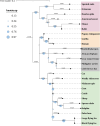Brown to White Fat Transition Overlap With Skeletal Muscle During Development of Larger Mammals: Is it a Coincidence?
- PMID: 36325536
- PMCID: PMC9611287
- DOI: 10.1210/jendso/bvac151
Brown to White Fat Transition Overlap With Skeletal Muscle During Development of Larger Mammals: Is it a Coincidence?
Abstract
In mammals, adipose tissues and skeletal muscles (SkMs) play a major role in the regulation of energy homeostasis. Recent studies point to a possibility of dynamic interplay between these 2 sites during development that has pathophysiological implications. Among adipose depots, brown adipose tissue (BAT) is the major energy-utilizing organ with several metabolic features that resemble SkM. Both organs are highly vascularized, innervated, and rich in mitochondria and participate in defining the whole-body metabolic rate. Interestingly, in large mammals BAT depots undergo a striking reduction and concomitant expansion of white adipose tissue (WAT) during postnatal development that shares temporal and molecular overlap with SkM maturation. The correlation between BAT to WAT transition and muscle development is not quite apparent in rodents, the predominantly used animal model. Therefore, the major aim of this article is to highlight this process in mammals with larger body size. The developmental interplay between muscle and BAT is closely intertwined with sexual dimorphism that is greatly influenced by hormones. Recent studies have pointed out that sympathetic inputs also determine the relative recruitment of either of the sites; however, the role of gender in this process has not been studied. Intriguingly, higher BAT content during early postnatal and pubertal periods positively correlates with attainment of better musculature, a key determinant of good health. Further insight into this topic will help in detailing the developmental overlap between the 2 seemingly unrelated tissues (BAT and SkM) and design strategies to target these sites to counter metabolic syndromes.
Keywords: adipose tissue; brown fat; larger mammals; myogenesis; perinatal development; skeletal muscle.
© The Author(s) 2022. Published by Oxford University Press on behalf of the Endocrine Society.
Figures




Similar articles
-
Developmental overlap between skeletal muscle maturation and perirenal fat brown-to-white transition in goats: Exploring the role of Myf-5.Biochimie. 2025 Jan;228:1-7. doi: 10.1016/j.biochi.2024.08.005. Epub 2024 Aug 7. Biochimie. 2025. PMID: 39121901
-
Contributions of white and brown adipose tissues and skeletal muscles to acute cold-induced metabolic responses in healthy men.J Physiol. 2015 Feb 1;593(3):701-14. doi: 10.1113/jphysiol.2014.283598. Epub 2014 Dec 15. J Physiol. 2015. PMID: 25384777 Free PMC article.
-
Electron Density of Adipose Tissues Determined by Phase-Contrast Computed Tomography Provides a Measure for Mitochondrial Density and Fat Content.Front Physiol. 2018 Jun 15;9:707. doi: 10.3389/fphys.2018.00707. eCollection 2018. Front Physiol. 2018. PMID: 29962958 Free PMC article.
-
White, brown, beige/brite: different adipose cells for different functions?Endocrinology. 2013 Sep;154(9):2992-3000. doi: 10.1210/en.2013-1403. Epub 2013 Jun 19. Endocrinology. 2013. PMID: 23782940 Review.
-
The "Skinny" on brown fat, obesity, and bone.Am J Phys Anthropol. 2015 Feb;156 Suppl 59:98-115. doi: 10.1002/ajpa.22661. Epub 2014 Nov 11. Am J Phys Anthropol. 2015. PMID: 25388370 Review.
Cited by
-
The crosstalk between BAT thermogenesis and skeletal muscle dysfunction.Front Physiol. 2023 Apr 21;14:1132830. doi: 10.3389/fphys.2023.1132830. eCollection 2023. Front Physiol. 2023. PMID: 37153220 Free PMC article. Review.
-
Meteorin-like levels are associated with active brown adipose tissue in early infancy.Front Endocrinol (Lausanne). 2023 Mar 2;14:1136245. doi: 10.3389/fendo.2023.1136245. eCollection 2023. Front Endocrinol (Lausanne). 2023. PMID: 36936161 Free PMC article.
-
CCE and EODF as two distinct non-shivering thermogenesis models inducing weight loss.Pflugers Arch. 2023 Aug;475(8):961-974. doi: 10.1007/s00424-023-02827-7. Epub 2023 Jun 15. Pflugers Arch. 2023. PMID: 37386129
-
Mitochondria-associated regulation in adipose tissues and potential reagents for obesity intervention.Front Endocrinol (Lausanne). 2023 Jun 16;14:1132342. doi: 10.3389/fendo.2023.1132342. eCollection 2023. Front Endocrinol (Lausanne). 2023. PMID: 37396170 Free PMC article.
-
Developmental dynamics of mitochondrial fission and fusion proteins in functionally divergent skeletal muscles of goat.Physiol Rep. 2024 Jun;12(11):e16002. doi: 10.14814/phy2.16002. Physiol Rep. 2024. PMID: 38831632 Free PMC article.
References
-
- Astrup A. Thermogenesis in human brown adipose tissue and skeletal muscle induced by sympathomimetic stimulation. Eur J Endocrinol. 1986;112(3_Suppl a):S9–S32. - PubMed
-
- Nedergaard J, Cannon B. The changed metabolic world with human brown adipose tissue: therapeutic visions. Cell Metab. 2010;11(4):268–272. - PubMed
-
- Matsushita M, Yoneshiro T, Aita S, Kameya T, Sugie H, Saito M. Impact of brown adipose tissue on body fatness and glucose metabolism in healthy humans. Int J Obes. 2014;38(6):812–817. - PubMed
Publication types
LinkOut - more resources
Full Text Sources
